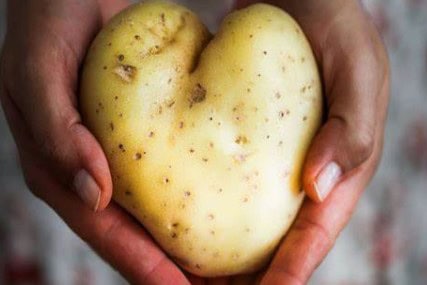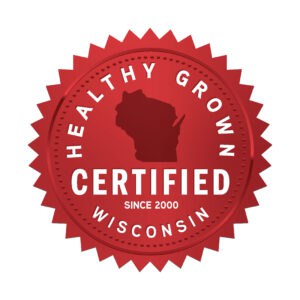Potatoes may surprise you as one of the best foods for cardiovascular health. Packed with potassium, fiber and vitamin C – and naturally sodium-free – they support healthy blood pressure and heart function. If you’re asking what food is good for heart health, Wisconsin potatoes are an answer worth exploring. Perfect for a low sodium diet for heart health, this versatile staple, when prepared properly, belongs on every heart-conscious plate. Registered dietitian nutritionist, Jenny Heap, explains.
By: Jenny Heap MS, RDN
Potatoes are one of the most beloved vegetables across cultures in the U.S. According to a recent survey, potatoes still play a significant role within family and cultural food traditions, with more than half of Hispanic, (54%), Black (52%), White (54%), and Native American (50%) respondents affirming that potatoes are a staple in their family and cultural food traditions.1 It’s no wonder potatoes so often take center plate. With those stats, it’s worth exploring how – with thoughtful preparation — this beloved staple can help protect our hearts.
Where Potatoes Stand Out Among Foods for Cardiovascular Health
Potatoes deliver several nutrients known to support cardiovascular health by sustaining proper heart function and helping keep blood pressure and serum cholesterol levels in check. One medium skin-on potato provides the following:
Vitamin C: 20 mg, 30% DV
Vitamin C is probably best known for its prominent role in immune function. But did you know that it has also recently been strongly linked to heart health? It’s thought that vitamin C might help prevent atherosclerosis, hypertension, and stroke2 and may be particularly related to blood pressure. A 2020 meta-analysis showed serum vitamin C levels to be significantly lower in study participants with hypertension vs. those with normal blood pressure.3
Potassium: 620 mg, 15% DV
Potassium is one of the unsung heroes of heart health. It is essential for proper function of the heart, as it is critical for proper muscle contraction, nerve transmission, and fluid balance. Research shows strong evidence that adequate potassium intake is associated with reduced risk of cardiovascular disease, especially coronary heart disease and stroke.4
The Dietary Guidelines for Americans 2020-2025 identified potassium as a nutrient of public health concern.5 The U.S. Food and Drug Administration has also updated the Nutrition Facts panel to include potassium content as a required declaration along with other nutrients of public health concern (dietary fiber, vitamin D, calcium, and iron). And for good reason. Potassium is commonly under-consumed and according to the CDC, heart disease is still the leading cause of death for both men and women, including those in most racial and ethnic groups.6
One of the most important ways potassium protects the heart is through moderation of blood pressure. Getting adequate potassium can help buffer the impact of sodium intake, which is typically high in the
U.S. populations. (Average intake of sodium is 3,393 mg/day vs. the recommended limit of 2,300 mg/day). Low-sodium diets paired with adequate potassium may be especially helpful in keeping blood pressure in check.7 In fact, insufficient potassium intake (common in the United States) can increase salt sensitivity, causing blood pressure to rise more than it normally would with sodium intake.8
It may be surprising, but potatoes are one of the best food sources of potassium and certainly the best source among foods commonly eaten in the U.S. Just one medium potato delivers 620 mg of potassium, (more than a banana). That’s 18% of the Daily Recommended Intake (DRI) for men and nearly 25% of the daily requirement for women. Though potassium is found primarily in the flesh of the potato, ~150 mg is lost when the skin is removed, so don’t peel before preparing if you want to optimize this cardioprotective nutrient.
Iron: 1.1 mg, 6% DV
Aside from its important role in oxygen transport, iron is essential for proper heart function. The heart is particularly dependent on energy supplied by the mitochondria, which need adequate iron levels to function.9
Though not a significant source of iron, potatoes’ impressive vitamin C content, and very low (to nonexistent) antinutrient levels make their bioavailability shine compared to that of many other plant foods rich in iron.10
Fiber: 2 g fiber, 7% DV
Though the exact mechanisms by which dietary fiber promotes heart health are not known, systematic reviews suggest that total dietary fiber intake is associated with a reduced risk of both diabetes11 and cardiovascular disease12. According to the CDC, the risk for cardiovascular disease doubles for those with diabetes. High blood glucose can damage nerves (including those that control the heart) and blood vessel walls, so reducing the risk of diabetes is an important way to protect the heart.
Research also suggests that adequate intake of both soluble and insoluble fiber can help improve blood pressure and blood lipid profiles.13 It is thought that soluble fiber improves cholesterol levels via fermentation and production of short-chain fatty acids (SCFAs) in the large intestine, some of which have been shown to decrease cholesterol synthesis in the liver. 14
Fiber is the only nutrient significantly reduced when a potato is peeled. Nearly 50% of the fiber is found in the skin, so leave the peel on to optimize the heart-health benefits.
Resistant Starch in Potatoes
Much of the carbohydrate in potatoes comes in the form of resistant starch (RS), an emerging topic of interest among researchers. Resistant starch is not broken down during digestion, but like soluble fiber, is fermented in the colon by gut microbes, producing short-chain fatty acids (SCFAs) believed to help regulate insulin sensitivity and glucose metabolism, heart rate, and blood lipid levels (as described previously). 15 16 17
Note: About 1/3 of the starch in a raw potato is resistant starch (RS), but the proportion varies greatly depending on the preparation method. The cooking process makes RS more digestible, thus decreasing the proportion of starch available to produce SCFAs. Cooling the potatoes after cooking returns much of the starch to its resistant state.
According to a 2019 study, cooling the potatoes for several days after cooking them maximized the RS content. Reheated potatoes retained much of the RS and ultimately provided more than the potatoes that were not cooled before eating. The study also indicated that RS was higher in baked vs. boiled potatoes.
How Potatoes fit in a Low Sodium Diet for Heart Health
In addition to being a good source of potassium, potatoes are naturally free of sodium.
Cooking Methods that Keep Potatoes Heart-Healthy
Potatoes can be an excellent food to support heart health – but preparation is key. To optimize cardiovascular benefits, use and encourage cooking methods and ingredients that minimize sodium and saturated fat and allow potatoes’ nutrients to shine.
Preparation tips:
- Leave the skin on to maximize fiber and other nutrients
- Bake, roast, steam, microwave, or air fry to preserve nutrients and minimize the need for added fats and oils.
- If boiling is needed, boil the whole potato with the skin on to minimize the loss of water-soluble vitamins and minerals. Cutting the potato into smaller pieces increases the surface area and results in greater nutrient losses.18
A baked potato is naturally full of heart-friendly nutrients. It can be loaded with toppings that detract or graced with ingredients that add value. Try these game-changing baked potato hacks:
- A squeeze of lemon (with or without unsalted butter) can be an elevated replacement for table salt that greatly reduces the sodium.
- A drizzle of olive oil in place of butter replaces saturated fat and sodium with healthy monounsaturated For a completely different experience, use a flavored olive oil that complements other toppings.
- Many favorite herbs and spices can be used in place of salt: garlic, green onion, oregano, dill, and more!
- Avocado slices add heart-healthy monounsaturated fat
- Greek yogurt can replace traditional sour cream for a nutrition The yogurt packs a punch with three times the protein, half the calories, and substantially less saturated fat than traditional sour cream.
Take Heart: Add Potatoes to a Heart-Healthy Lifestyle
Packed with heart-healthy nutrients, potatoes are a delicious way to support heart health this February and beyond. Give these dietitian-created tips a try!
Content produced in partnership with the Wisconsin Potato and Vegetable Growers Association. Wisconsin Potato and Vegetable Growers Association represents growers committed to good agriculture, food safety, nutrition, traceability, and providing America with fresh, high-quality produce.
Wisconsin-grown potatoes offer more than just great taste. Local and sustainably sourced, they’re packed with nutrition no matter the variety. Every one of our Wisconsin Healthy Grown® farms is certified by an independent oversight organization. It ensures our growers pass annual Wisconsin Healthy Grown® Potato and Vegetable whole-farm audits, and that all our packers and shippers maintain the highest sustainability standards.
Look for the Wisconsin Healthy Grown® certification seal on your potatoes and explore more at eatwisconsinpotatoes.com!
About the Author:
Jenny Heap, MS, RDN, is a registered dietitian nutritionist who contributes nutrition expertise to the educational outreach of Wisconsin Potato and Vegetable Growers Association. Connect with Jenny on LinkedIn.



